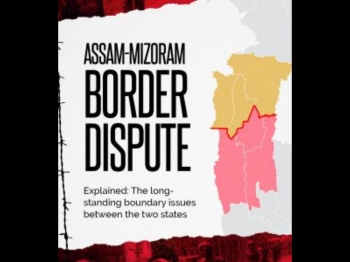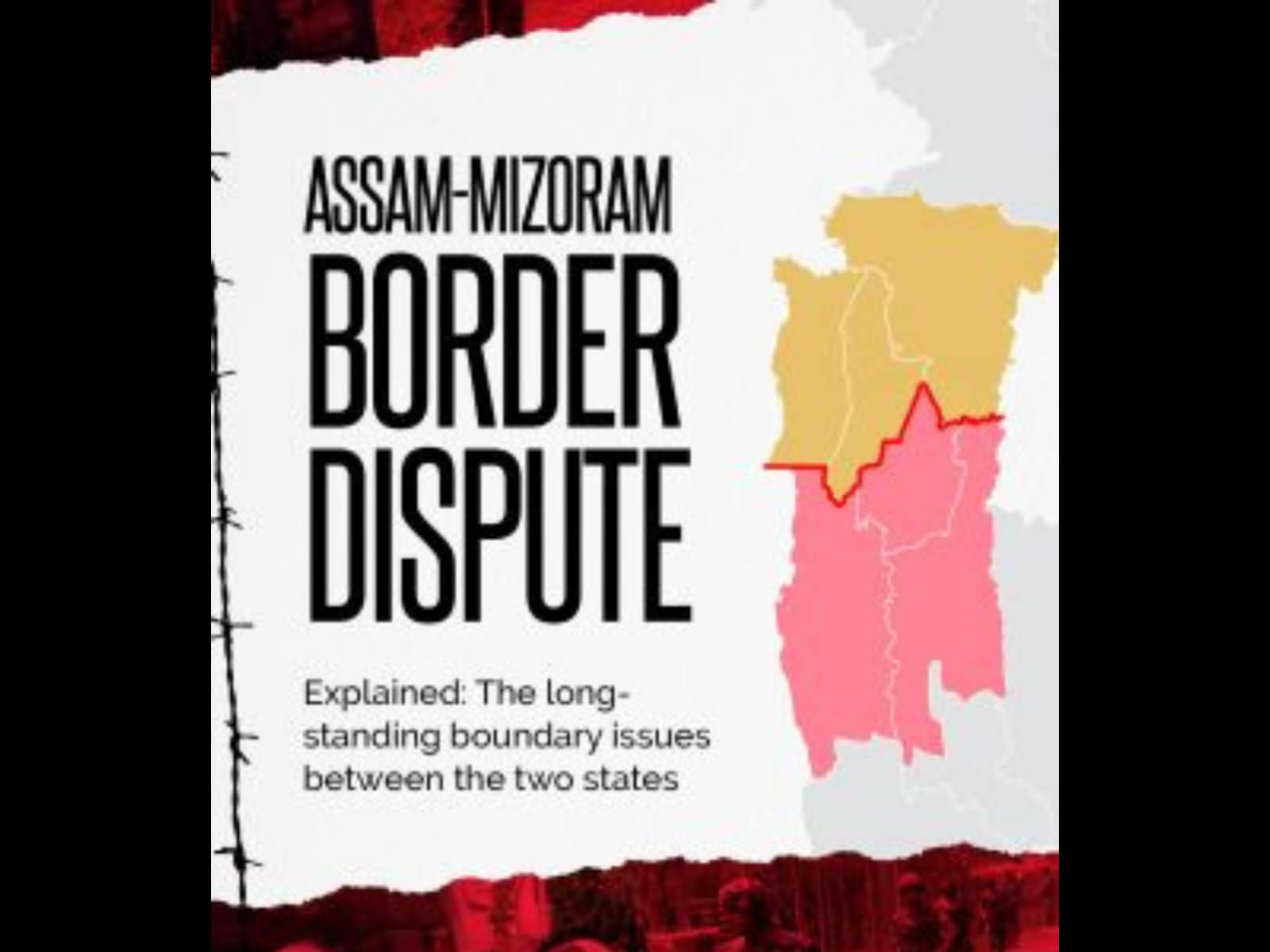
.png) Albert Thyrniang
Albert Thyrniang

Security forces are killed due to gun battles on international borders not on inter-state boundaries. But in a shocking incident on 26th July, six Assam police personnel lost their lives and at least 50 injured on the Assam-Mizoram border in police firing between the forces of the two North Eastern States. Videos and images emerged from the scene of the confrontation were widely shared in the social media and were beamed by national media that debated and analysed the clash between the two neighbouring states. What led to this unprecedented full-blown violence and what is the way forward?
The genesis
The crisis traces back to two colonial border demarcations, one almost 150-year-old. Notified on August 20, 1875 the British drew the line of demarcation between Lushai Hills district (Now Mizoram state) and Cachar district in the plain of Assam’s Barak Valley. Done under the Bengal Eastern Frontier Regulation (BEFR) Act 1873, the delineation was carried out in consultation with Mizo chiefs and hence the people of Mizoram accepted this demarcation.
Another exercise was undertaken in 1933 that marks the boundary between Lushai Hills and the princely state of Manipur. This boundary begins at the tri-junction of Lushai Hills, Cachar district and Manipur. The people of Mizoram reject this demarcation as their chiefs were not consulted unlike in 1875. According to the Mizoram joint action committee on the border issue, the 1933 boundary unreasonably excluded Lushai (Mizo) inhabited areas like Cachar Zion, Tlangnuam, Lala Bazar and Banga Bazar and was drawn without the consent and approval of the competent authorities and the people of the Lushai Hills.
In short, the dispute is because Assam insists that their boundary is as per the 1933 demarcation while Mizoram is adamant that their border is according to the 1875 demarcation.
Simmering situation
Ever since Mizoram became a Union Territory in 1972 and then a full-fledged State in 1987 the border dispute has been Simmering. Erupted skirmishes often led to scuffles but none led to bloodshed. Though the two states signed an agreement that status quo should be maintained at the ‘no-man’s land’ each have accused the other of transgressions. Days prior to the latest bloodshed, tension was building up on the inter-state border. The Assam Chief Minister, Himanta Biswa Sarma, and the Mizoram counterpart, Zoramthanga, were engaged in a twitter war of words. Barely 48 hours before the firing took place both the Chief Ministers were in Shillong for talks with Union Home Minister Amit Shah in their midst urging them to resolve the long standing difference amicably.
The events leading to the bloodshed are unclear. Claims and counter claims flew thick and fast from both sides, each alleging the other fired first. However, the first and decisive move was made by Assam. In the morning of the ill-fated day a team of Assam police personnel led by an Inspector General proceeded to the disputed site. The Assam government’s decision was to “diffuse the situation and resolve matters”. Mizoram, on the other hand, saw the ‘march’ an aggressive move as the force had crossed a post staffed by the CRPF and “overran a duty post” manned by the Mizoram police.
The border incident took everyone by surprize. It looks as if the authority of Amit Shah has been undermined. But is it really so? The focus is on the Assam Chief Minister. Politicians from his party and partners look to him. The Opposition has blamed him. Analysts are still fathoming the unexpected bloodshed.
Personal ambition a factor?
Himanta Biswa Sarma was a former Congressman. He rebelled against the then three-time Chief Minister Tarun Gogoi because he wanted to be Chief Minister. He defected to the BJP in 2015 in the hope the party would nominate him to the top post if it ended the 15- year rule of the Congress. He did contribute to the rousing maiden victory of the BJP but disappointing for Sarma, Sarbananda Sonowal was made Chief Minister.
However, as Health and Education Minister Sarma was the face and the voice of the Sonowal government. The Chief Minister was hardly seen and heard. Sarma’s clout grew rapidly in his own state and in the entire North East. He was largely instrumental in forming the North-East Democratic Alliance (NEDA), a NDA regional sub-group that aims for a ‘Congress-mukt’ in the North East. As its convener he worked hard so that by 2018, the grand old party that once monopolised power in all the seven states was decimated. The BJP central leadership was highly impressed. Sarma’s only motivation was to become the Chief Minister of the largest state in the North East. Everything was geared towards that direction.
Sarma’s ambition was fulfilled after this year’s Assembly election when his party historically returned to power. Having used his clouts to distribute party tickets to candidates close to him, the BJP central leadership had no choice but to opt him in favour of the soft spoken Sonowal. Now that his life-long desire has been achieved, Sarma has to consolidate his position in Assam. It is believed that the order to go to the Mizoram border came directly from the Chief Minister’s office. He wants to be seen as the undisputed leader in his state.
In the aftermath of the tragedy, he talked provocatively vowing not to yield an ‘inch of land to Mizoram’ while announcing to “deploy 4000 commandos in the district bordering Mizoram. Cases against Mizoram police have been registered and a conspiracy angle involving Mizoram Rajya Sabha MP, K. Vanlalvena and other politicians is being probed.
Prior to the tragic clash, Sarma had offered to resolve the border disputes with all neighbouring states before the 75th Independence Day of the country. Assam has most inter-state border disputes (4 out 7) in India involving Arunachal Pradesh, Nagaland, Meghalaya and Mizoram. Two days earlier Sarma was in Shillong to discuss the border issue with Meghalaya Chief Minster Conrad Sangma and came up with the suggestion of ‘give and take” to settle the dispute that has lingered for decades. The Assam Chief Minister wants to make a major mark during his tenure. And what better mark than solving the long pending disputes! He wants to live up to the image as the most powerful politician in the North East. Incidentally on the same day Assam police were also involved in skirmish along the Meghalaya border. The Chief Minister wants to preserve the perception that Assam is a big brother. Now he wants that his state bullies the smaller states.
Sarma has also antagonised tribal leaders. Ever since he became Chief Minister he has been uttering Hindutva voices. He stated that ‘most of us’ descended from Hinduism. He introduced a cow protection Bill that proposes to ban cattle transports to neighbouring states. Is the approach of the Assam Chief Minister correct? Is his method aggressive and antagonising? Is he pursuing the border issue expecting quick outcome without consultation, forming of committees and consensus building? Is he in danger of dividing of the North East? The region is always seen as a unified block that is neglected and backward. Has his personal ambition played a part in the current hostility? At what price should his state and the North East pay? Assam could stand to lose. Social media users in neighbouring states are sympathetic towards Mizoram. Will the Assam action could backfire?
Victims of politics
While politics is played out even for personal ambition, the areas under dispute have suffered gravely. They are children of no body. They are totally neglected. They are without basic amenities like schools, roads, water and electricity. Just imagine, the aforementioned skirmish with Meghalaya was because the Assam police went in buses to remove four electric posts that Meghalaya had erected in a village called Longkhuli. Till this day and age that village is in darkness.
The way forward
It is an accepted fact that successive Central governments have not taken border disputes seriously. With no solution in sight, suggestions are offered to turn the contested areas into economic zones and educational hubs where they are homes to IT parks, health centres and tourist facilities. These areas could also become centrally administered territories for the overall development rather being hosts to petty politics.